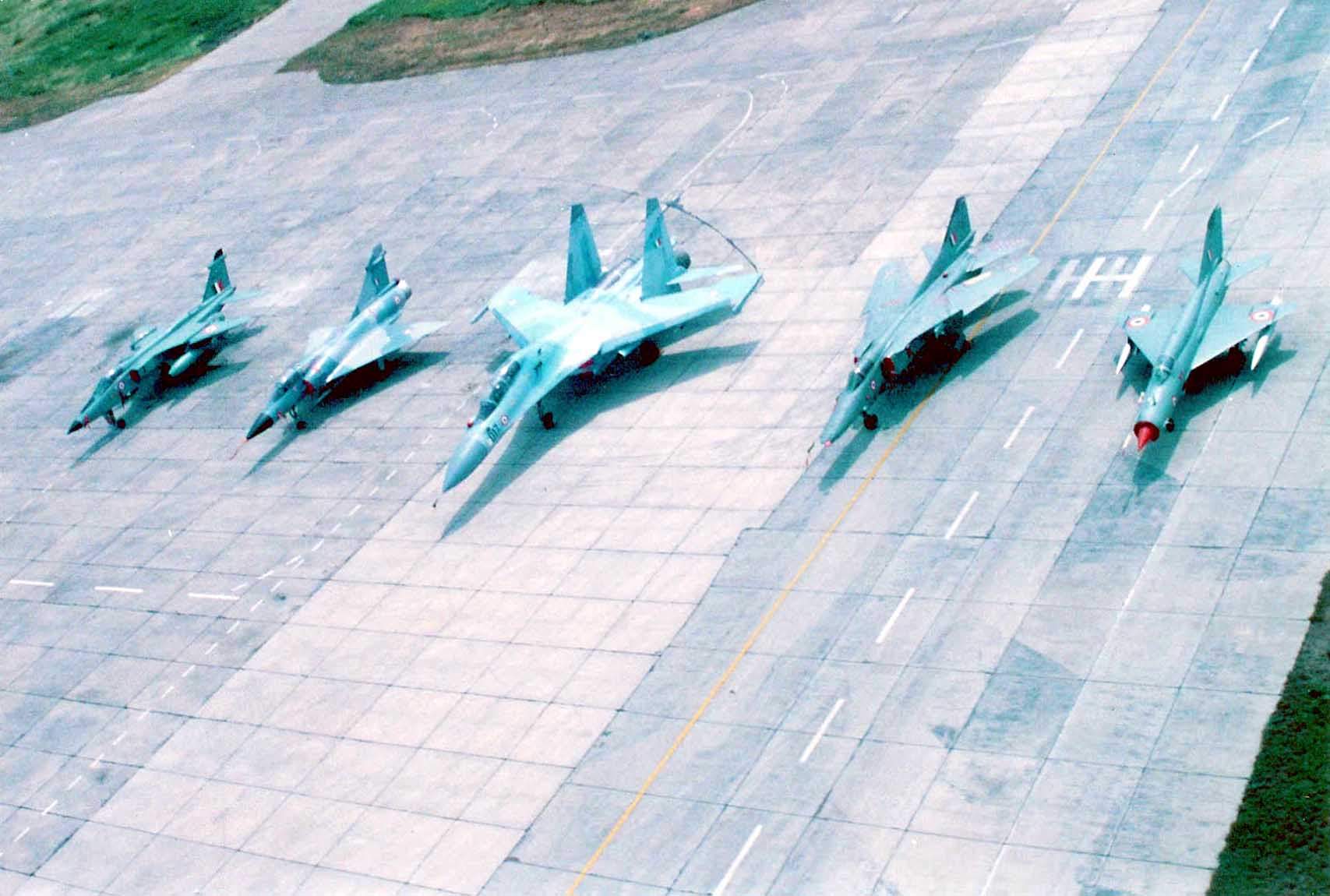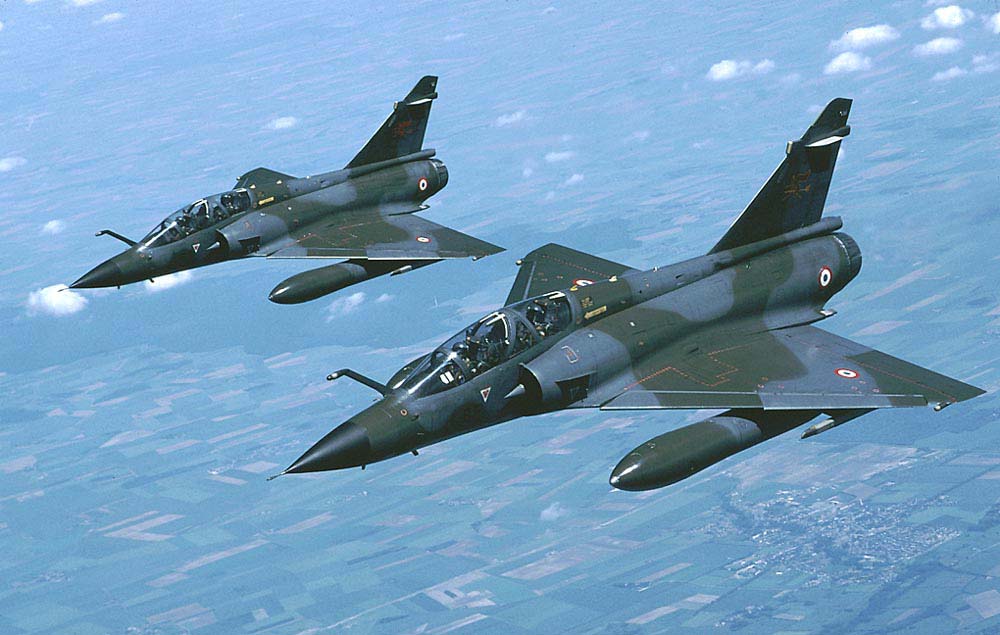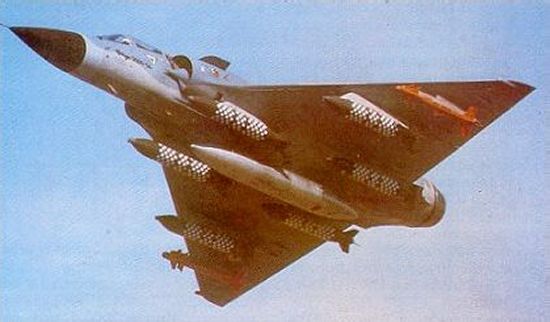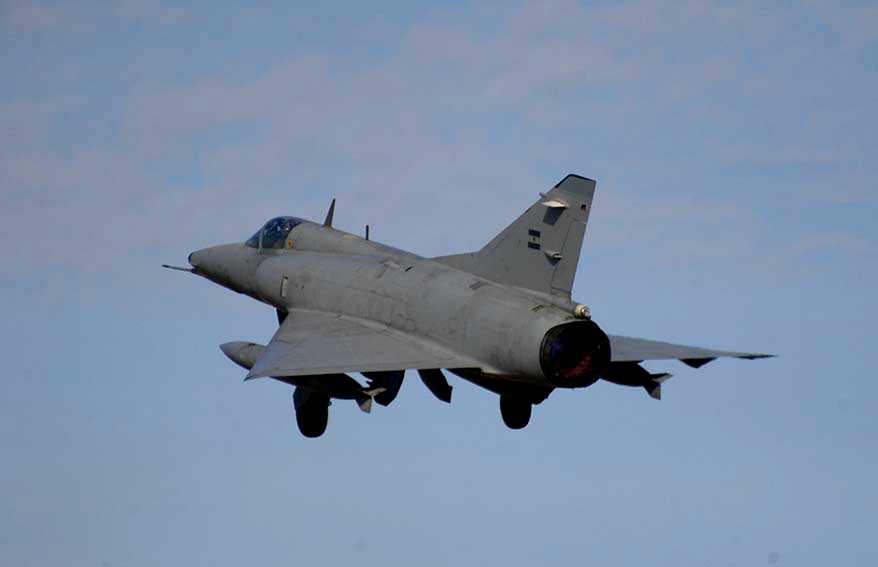Mirage Fighter Jet Biography
The Mirage III family grew out of French government studies began in 1952 that led in early 1953 to a specification for a lightweight, all-weather interceptor capable of climbing to 18,000 m (59,040 ft) in six minutes and able to reach Mach 1.3 in level flight.[citation needed]
Dassault's response to the specification was the Mystère-Delta 550, a diminutive and sleek jet that was to be powered by twin Armstrong Siddeley MD30R Viper afterburning turbojets, each with thrust of 9.61 kN (2,160 lbf). A SEPR liquid-fuel rocket motor was to provide additional burst thrust of 14.7 kN (3,300 lbf). The aircraft had a tailless delta configuration, with a 5% chord (ratio of airfoil thickness to length) and 60 degree sweep.[citation needed]
The tailless delta configuration has a number of limitations. The lack of a horizontal stabilizer meant flaps cannot be used, resulting in a long takeoff run and a high landing speed.[citation needed] The delta wing itself limits maneuverability; and suffers from buffeting at low altitude, due to the large wing area and resulting low wing loading. However, the delta is a simple and pleasing design, easily built and robust, capable of high speed in a straight line, and with plenty of space in the wing for fuel storage.[citation needed]
The first prototype of the Mystere-Delta, without afterburning engine or rocket motor and with an unusually large vertical stabilizer, flew on 25 June 1955.[2] After some redesign, reduction of the fin to more rational size, installation of afterburners and rocket motor, and renaming to Mirage I, in late 1955, the prototype attained Mach 1.3 in level flight without rocket assist, and Mach 1.6 with the rocket.[citation needed]
The Mirage prototype with the large vertical stabilizer.
However, the small size of the Mirage I restricted its armament to a single air-to-air missile, and even before this time it had been prudently decided the aircraft was simply too tiny to carry a useful armament load. After trials, the Mirage I prototype was eventually scrapped.[citation needed]
Dassault then considered a somewhat bigger version, the Mirage II, with a pair of Turbomeca Gabizo turbojets, but no aircraft of this configuration was ever built. The Mirage II was bypassed for a much more ambitious design that was 30% heavier than the Mirage I and was powered by the new SNECMA Atar afterburning turbojet with thrust of 43.2 kN (9,700 lbf). The Atar was an axial flow turbojet, derived from the German World War II BMW 003 design.[citation needed]
The new fighter design was named the Mirage III. It incorporated the new area ruling concept, where changes to the cross section of an aircraft were made as gradual as possible, resulting in the famous "wasp waist" configuration of many supersonic fighters. Like the Mirage I, the Mirage III had provision for a SEPR rocket engine.[citation needed]
Cutaway view of the Cyrano radar system
The prototype Mirage III flew on 17 November 1956,[2] and attained a speed of Mach 1.52 on its tenth flight.[3] The prototype was then fitted with manually operated intake half-cone shock diffusers, known as souris ("mice"), which were moved forward as speed increased to reduce inlet turbulence. The Mirage III attained a speed of Mach 1.8 in September 1957.[3]
The success of the Mirage III prototype resulted in an order for 10 pre-production Mirage IIIAs. These were almost two meters longer than the Mirage III prototype, had a wing with 17.3% more area, a chord reduced to 4.5%, and an Atar 09B turbojet with afterburning thrust of 58.9 kN (13,230 lbf). The SEPR rocket engine was retained, and the aircraft were fitted with Thomson-CSF Cyrano Ibis air intercept radar, operational avionics, and a drag chute to shorten landing roll.[citation needed]
The first Mirage IIIA flew in May 1958, and eventually was clocked at Mach 2.2, making it the first European aircraft to exceed Mach 2 in level flight. The tenth IIIA was rolled out in December 1959. One was fitted with a Rolls-Royce Avon 67 engine with thrust of 71.1 kN (16,000 lbf) as a test model for Australian evaluation, with the name "Mirage IIIO". This variant flew in February 1961, but the Avon powerplant was not adopted.[citation needed]
The belly of a Mirage IIIS
[edit]Mirage IIIC and Mirage IIIB
At Cazaux airfield near Bordeaux was offered by the French Government. Both French Air Force and Dassault personnel were at the airfield along with the Fairey team. Forty-seven low-level supersonic flights took place over a period of two months. It was no coincidence that Dassault had their engineers at Cazaux as they, like Fairey, were interested in delta wing fighters and during the FD.2s tests they learned much about the characteristics of supersonic delta wings. Two days after the FD.2 had returned home the first Mirage III prototype was rolled out.
As Marcel Dassault, the founder of the company, said in the book Mirage, Warplane of the World, "If it were not for the clumsy way in which you tackle things in Britain, you could have made the Mirage yourselves".[this quote needs a citation] The first major production model of the Mirage series, the Mirage IIIC, first flew in October 1960. The IIIC was largely similar to the IIIA, though a little under a half meter longer and brought up to full operational fit. The IIIC was a single-seat interceptor, with an Atar 09B turbojet engine, featuring an "eyelet" style variable exhaust.[citation needed]
The Mirage IIIC was armed with twin 30 mm DEFA revolver-type cannon, fitted in the belly with the gun ports under the air intake. Early Mirage IIIC production had three stores pylons, one under the fuselage and one under each wing, but another outboard pylon was quickly added to each wing, for a total of five. The outboard pylon was intended to carry an AIM-9 Sidewinder air-to-air missile, later replaced by the Matra Magic.[citation needed]
Although provision for the rocket engine was retained, by this time the day of the high-altitude bomber seemed to be over, and the SEPR rocket engine was rarely or never fitted in practice. In the first place, it required removal of the aircraft's cannon, and in the second, apparently it had a reputation for setting the aircraft on fire.[citation needed] The space for the rocket engine was used for additional fuel, and the rocket nozzle was replaced by a ventral fin at first, and an airfield arresting assembly later.[citation needed]
A total of 95 Mirage IIICs were obtained by the French Air Force (Armée de l'Air, AdA), with initial operational deliveries in July 1961. The Mirage IIIC remained in service with the AdA until 1988.[citation needed]
The Armée de l'Air also ordered a two-seat Mirage IIIB operational trainer, which first flew in October 1959. The fuselage was stretched about a meter (3 ft 3.5 in) and both cannons were removed to accommodate the second seat. The IIIB had no radar, and provision for the SEPR rocket was deleted, although it could carry external stores. The AdA ordered 63 Mirage IIIBs (including the prototype), including five Mirage IIIB-1 trials aircraft, ten Mirage IIIB-2(RV) inflight refueling trainers with dummy nose probes, used for training Mirage IVA bomber pilots, and 20 Mirage IIIBEs, with the engine and some other features of the multi-role Mirage IIIE. One Mirage IIIB was fitted with a fly-by-wire flight control system in the mid-1970s and redesignated Mirage IIIB-SV (Stabilité Variable); this aircraft was used as a testbed for the system in the later Mirage 2000.[citation needed]
The Mirage III family grew out of French government studies began in 1952 that led in early 1953 to a specification for a lightweight, all-weather interceptor capable of climbing to 18,000 m (59,040 ft) in six minutes and able to reach Mach 1.3 in level flight.[citation needed]
Dassault's response to the specification was the Mystère-Delta 550, a diminutive and sleek jet that was to be powered by twin Armstrong Siddeley MD30R Viper afterburning turbojets, each with thrust of 9.61 kN (2,160 lbf). A SEPR liquid-fuel rocket motor was to provide additional burst thrust of 14.7 kN (3,300 lbf). The aircraft had a tailless delta configuration, with a 5% chord (ratio of airfoil thickness to length) and 60 degree sweep.[citation needed]
The tailless delta configuration has a number of limitations. The lack of a horizontal stabilizer meant flaps cannot be used, resulting in a long takeoff run and a high landing speed.[citation needed] The delta wing itself limits maneuverability; and suffers from buffeting at low altitude, due to the large wing area and resulting low wing loading. However, the delta is a simple and pleasing design, easily built and robust, capable of high speed in a straight line, and with plenty of space in the wing for fuel storage.[citation needed]
The first prototype of the Mystere-Delta, without afterburning engine or rocket motor and with an unusually large vertical stabilizer, flew on 25 June 1955.[2] After some redesign, reduction of the fin to more rational size, installation of afterburners and rocket motor, and renaming to Mirage I, in late 1955, the prototype attained Mach 1.3 in level flight without rocket assist, and Mach 1.6 with the rocket.[citation needed]
The Mirage prototype with the large vertical stabilizer.
However, the small size of the Mirage I restricted its armament to a single air-to-air missile, and even before this time it had been prudently decided the aircraft was simply too tiny to carry a useful armament load. After trials, the Mirage I prototype was eventually scrapped.[citation needed]
Dassault then considered a somewhat bigger version, the Mirage II, with a pair of Turbomeca Gabizo turbojets, but no aircraft of this configuration was ever built. The Mirage II was bypassed for a much more ambitious design that was 30% heavier than the Mirage I and was powered by the new SNECMA Atar afterburning turbojet with thrust of 43.2 kN (9,700 lbf). The Atar was an axial flow turbojet, derived from the German World War II BMW 003 design.[citation needed]
The new fighter design was named the Mirage III. It incorporated the new area ruling concept, where changes to the cross section of an aircraft were made as gradual as possible, resulting in the famous "wasp waist" configuration of many supersonic fighters. Like the Mirage I, the Mirage III had provision for a SEPR rocket engine.[citation needed]
Cutaway view of the Cyrano radar system
The prototype Mirage III flew on 17 November 1956,[2] and attained a speed of Mach 1.52 on its tenth flight.[3] The prototype was then fitted with manually operated intake half-cone shock diffusers, known as souris ("mice"), which were moved forward as speed increased to reduce inlet turbulence. The Mirage III attained a speed of Mach 1.8 in September 1957.[3]
The success of the Mirage III prototype resulted in an order for 10 pre-production Mirage IIIAs. These were almost two meters longer than the Mirage III prototype, had a wing with 17.3% more area, a chord reduced to 4.5%, and an Atar 09B turbojet with afterburning thrust of 58.9 kN (13,230 lbf). The SEPR rocket engine was retained, and the aircraft were fitted with Thomson-CSF Cyrano Ibis air intercept radar, operational avionics, and a drag chute to shorten landing roll.[citation needed]
The first Mirage IIIA flew in May 1958, and eventually was clocked at Mach 2.2, making it the first European aircraft to exceed Mach 2 in level flight. The tenth IIIA was rolled out in December 1959. One was fitted with a Rolls-Royce Avon 67 engine with thrust of 71.1 kN (16,000 lbf) as a test model for Australian evaluation, with the name "Mirage IIIO". This variant flew in February 1961, but the Avon powerplant was not adopted.[citation needed]
The belly of a Mirage IIIS
[edit]Mirage IIIC and Mirage IIIB
At Cazaux airfield near Bordeaux was offered by the French Government. Both French Air Force and Dassault personnel were at the airfield along with the Fairey team. Forty-seven low-level supersonic flights took place over a period of two months. It was no coincidence that Dassault had their engineers at Cazaux as they, like Fairey, were interested in delta wing fighters and during the FD.2s tests they learned much about the characteristics of supersonic delta wings. Two days after the FD.2 had returned home the first Mirage III prototype was rolled out.
As Marcel Dassault, the founder of the company, said in the book Mirage, Warplane of the World, "If it were not for the clumsy way in which you tackle things in Britain, you could have made the Mirage yourselves".[this quote needs a citation] The first major production model of the Mirage series, the Mirage IIIC, first flew in October 1960. The IIIC was largely similar to the IIIA, though a little under a half meter longer and brought up to full operational fit. The IIIC was a single-seat interceptor, with an Atar 09B turbojet engine, featuring an "eyelet" style variable exhaust.[citation needed]
The Mirage IIIC was armed with twin 30 mm DEFA revolver-type cannon, fitted in the belly with the gun ports under the air intake. Early Mirage IIIC production had three stores pylons, one under the fuselage and one under each wing, but another outboard pylon was quickly added to each wing, for a total of five. The outboard pylon was intended to carry an AIM-9 Sidewinder air-to-air missile, later replaced by the Matra Magic.[citation needed]
Although provision for the rocket engine was retained, by this time the day of the high-altitude bomber seemed to be over, and the SEPR rocket engine was rarely or never fitted in practice. In the first place, it required removal of the aircraft's cannon, and in the second, apparently it had a reputation for setting the aircraft on fire.[citation needed] The space for the rocket engine was used for additional fuel, and the rocket nozzle was replaced by a ventral fin at first, and an airfield arresting assembly later.[citation needed]
A total of 95 Mirage IIICs were obtained by the French Air Force (Armée de l'Air, AdA), with initial operational deliveries in July 1961. The Mirage IIIC remained in service with the AdA until 1988.[citation needed]
The Armée de l'Air also ordered a two-seat Mirage IIIB operational trainer, which first flew in October 1959. The fuselage was stretched about a meter (3 ft 3.5 in) and both cannons were removed to accommodate the second seat. The IIIB had no radar, and provision for the SEPR rocket was deleted, although it could carry external stores. The AdA ordered 63 Mirage IIIBs (including the prototype), including five Mirage IIIB-1 trials aircraft, ten Mirage IIIB-2(RV) inflight refueling trainers with dummy nose probes, used for training Mirage IVA bomber pilots, and 20 Mirage IIIBEs, with the engine and some other features of the multi-role Mirage IIIE. One Mirage IIIB was fitted with a fly-by-wire flight control system in the mid-1970s and redesignated Mirage IIIB-SV (Stabilité Variable); this aircraft was used as a testbed for the system in the later Mirage 2000.[citation needed]
Mirage Fighter Jet
Mirage Fighter Jet
Mirage Fighter Jet
Mirage Fighter Jet
Mirage Fighter Jet
Mirage Fighter Jet
Mirage Fighter Jet
Mirage Fighter Jet
Mirage Fighter Jet
Mirage Fighter Jet
Mirage Fighter Jet
Mirage Fighter Jet
Mirage Fighter Jet
Mirage Fighter Jet
Mirage Fighter Jet
Mirage Fighter Jet
Mirage Fighter Jet
Mirage Fighter Jet
Mirage Fighter Jet
Mirage Fighter Jet



.jpg/300px-Mirage_2000C_in-flight_2_(cropped).jpg)












_002.jpg)


No comments:
Post a Comment